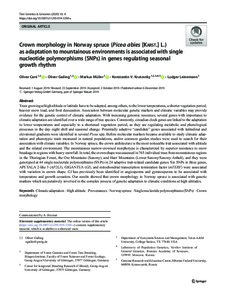Crown morphology in Norway spruce (Picea abies [Karst.] L.) as adaptation to mountainous environments is associated with single nucleotide polymorphisms (SNPs) in genes regulating seasonal growth rhythm
Скачать файл:
URI (для ссылок/цитирований):
https://elib.sfu-kras.ru/handle/2311/137961Автор:
Care Oliver
Gailing Oliver
Mueller Markus
Krutovsky Konstantin
Leinemann Ludger
Дата:
2020Журнал:
Tree Genetics and GenomesКвартиль журнала в Scopus:
даКвартиль журнала в Web of Science:
даСтатья из журнала.
Аннотация:
Trees growing at high altitude or latitude have to be adapted, among others, to the lower temperatures, a shorter vegetation period, heavier snow load, and frost desiccation. Association between molecular genetic markers and climatic variables may provide evidence for the genetic control of climatic adaptation. With increasing genomic resources, several genes with importance to climatic adaptation are identified over a wide range of tree species. Commonly, circadian clock genes are linked to the adaptation to lower temperatures and especially to a shortened vegetation period, as they are regulating metabolic and phenological processes in the day–night shift and seasonal change. Potentially adaptive “candidate” genes associated with latitudinal and elevational gradients were identified in several Picea spp. Before molecular markers became available to study climatic adaptation and phenotypic traits measured in natural populations, and/or common garden studies were used to search for their association with climate variables. In Norway spruce, the crown architecture is the most noticeable trait associated with altitude and the related environment. The mountainous narrow-crowned morphotype is characterized by superior resistance to snow breakage in regions with heavy snowfall. In total, the crown shape was assessed in 765 individual trees from mountainous regions in the Thuringian Forest, the Ore Mountains (Saxony), and Harz Mountains (Lower-Saxony/Saxony-Anhalt), and they were genotyped at 44 single nucleotide polymorphisms (SNPs) in 24 adaptive trait-related candidate genes. Six SNPs in three genes, APETALA 2-like 3 (AP2L3), GIGANTEA (GI), and mitochondrial transcription termination factor (mTERF) were associated with variation in crown shape. GI has previously been identified in angiosperms and gymnosperms to be associated with temperature and growth cessation. Our results showed that crown morphology in Norway spruce is associated with genetic markers which are putatively involved in the complex process of genetic adaptation to climatic conditions at high altitudes. © 2019, Springer-Verlag GmbH Germany, part of Springer Nature.

